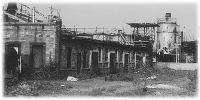Here's How You
|
 |
Here's How You
|
 |
 |
Into an Asset! |
 |
New Jersey has a long history of industrialization
that left thousands of contaminated sites and abandoned
properties in its wake. Your town may have one, or
several, such sites. Public attention has focused since the 1970's on the need to clean up contaminated land and water areas. This process, however, is time-consuming and expensive. When there is no one to pay for a cleanup, and no one is interested in purchasing and redeveloping a property because of legal or financial concerns, these eyesores can blight a community's landscape and threaten its economy long into the future. Here's one way that a community - your community - might be able to rid itself of such an economically, visually, and environmentally undesirable burden. |
The Siting Board has the responsibility for ensuring the dependable, long-term disposal of low-level radioactive waste generated by New Jersey's nuclear power planrs, pharmaceutical and other industries, research labs, hospitals and universities. The Siting Board, which has adopted a VOLUNTARY APPROACH to finding a suitable site for the State's disposal facility, has been asked many times IF A CONTAMINATED SITE COULD BE CONSIDERED as the location for New Jersey's low-level radioactive waste disposal facility. The answer is: YES, IT COULD.
There are no regulations that would prohibit siting a disposal facility on contaminated land. The only proviso, according to the U.S. Nuclear Regulatory Commission, which has the statutory responsibility for licensing disposal facilities, is that STRINGENT PERFORMANCE AND MONITORING STANDARDS established for the facility - the same standards that apply to unspoiled land - CANNOT BE COMPROMISED.
Many New Jersey communities may well have parcels of land of AT LEAST 100 ACRES, 50 of which must be located outside a 100-year flood plain, which include (or are near) contaminated property. If your community is willing to consider the possibility of hosting New Jersey's disposal facility - which will be a low-impact, light industrial operation - the Siting Board would like to work with you to learn if such a site might be suitable for New Jersey's disposal facility. This would include effectively cleaning up the site, and TURNING AN EYESORE INTO AN ASSET.
Consider:
|
 |
 |
|
|
 |
 |
|
Of course, there are technical, legal, financial and institutional issues which would need to be addressed by both the Siting Board and the community in evaluating contaminated property as a potential site for New Jersey's low-level radioactive waste disposal facility. ANY SUCH PROPERTY OFFERED FOR CONSIDERATION WOULD REQUIRE A SITE-SPECIFIC EVALUATION BY THE BOARD AND ITS CONSULTING ENGINEERS AND SCIENTISTS.
Return to Public Information Material home page
![]() Back to the Siting Board Home Page
Back to the Siting Board Home Page
Last updated September 1997